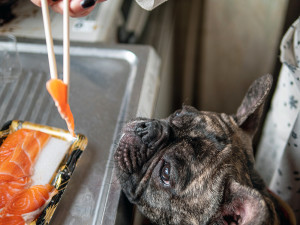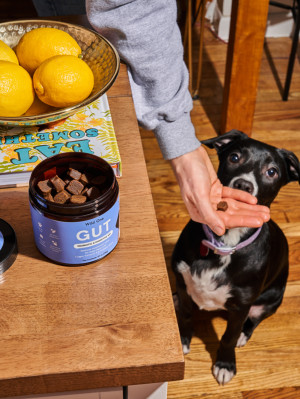Can Dogs Eat Cranberries? Learn if They Are Toxic or Not
Read this before sharing your snack with your dog.

Share Article
In This Article:
Can Dogs Eat Cranberries? Nutritional Benefits of Cranberries How to Safely Feed Your Dog Cranberries What Types of Cranberries Can Dogs Have?
With a refreshing, tangy taste and a lovely pop of red color, cranberries provide all that and more to human snacks and foods. They can also be quite enticing when dried like raisins, but are they something you’ll want to offer your dog? Fortunately, cranberries aren’t toxic to dogs and can actually provide a nutritional boost if fed in moderation. Looking to share cranberries with your dog? Read on first.
Can dogs eat cranberries?
Cranberries aren’t toxic to dogs and can even be healthy for them. But that doesn’t mean you’ll want to share cranberries with your pup in all their forms. You’ll also want to be particular about how much you feed them.
How much do you spend on your pet per year?

Nutritional benefits of cranberries for dogs
Cranberries have reached superfood statusopens in new tab because they nearly have it all. They’re low in calories, low in sugar, high in antioxidants, and the list goes on and on.
Are cranberries good for dogs?
We know that most dogs can use low-calorie snack options — and certainly ones that are low in sugar. But check out what else cranberries have going for your dog.
Antioxidants: Things like anthocyanins, ursolic acid, and quercetin can help reduce inflammation, boost the immune system, and prevent chronic disease.
Fiber: A healthy dose can regulate digestion and help a pup feel full, so they don’t beg as much.
Urinary health: Cranberries may help prevent recurrent urinary tract infections.
Vitamins C, A, and K: The fruit can boost the immune system, prevent blood clotting, and improve vision.
Are cranberries bad for dogs?
Though cranberries come with many positive benefits, feeding them to your dog does have a few downsides. These are more of a problem if your dog is getting unrestricted access to them, or if they gobble a bunch without your supervision.
Choke: Whole cranberries can be quite large for a small dog to eat, especially if swallowed whole, potentially causing a dog to chokeopens in new tab.
Digestive upset: Although they may like the taste, your dog’s digestive system isn’t set up to deal with a lot of sugar or acid, both of which can be found in cranberries. Eating too many can lead to diarrhea, vomiting, stomach pain, and loss of appetite.
Cranberry products: Cookies, cakes, or snacks containing cranberries may be an issue — not necessarily from the cranberries, but from the other ingredients in them. Milk, butter, and other ingredients also cause digestive upset, weight gain, among other issues.
How to safely feed your dog cranberries
If your dog is craving a little tartness in their otherwise savory diet, you may add a few cranberries, but there are some rules to follow.
First, make sure to only give them plain cranberries. No added sugars or flavorings are necessary. You can give them to your dog raw or cooked. If raw, wash thoroughly and chop into smaller pieces for smaller dogs.
If this is the first time feeding cranberries to your dog, give them a small bite and then monitor their reactions. If all’s OK, you may gradually increase the serving size.
How much cranberry can dogs have?
The cranberry serving size is going to depend on the size of your dog. Small dogs can usually handle one to two cranberries at a time, while medium-sized breeds can have five to six, and large and giant breeds can eat eight to 10 in a sitting. Keep cranberries as an occasional treat, only a few times a week.
What types of cranberries can dogs have or not have?
Raw and cooked
These are OK, just keep the portion sizes appropriate.
Dried
Dogs may also indulge in dried cranberries. They have a higher concentration of sugar, so keep the portion size even smaller than with raw or cooked versions.
Cranberry sauce
This is OK when it’s a homemade formulation made entirely of cranberries without added sugars or flavorings. But don’t feed your dog store-bought varieties.
Cranberry juice
Cranberry juice isn’t the best thing to give your dog because of the sugar content. Avoid sugar-free options as well, as those could contain xylitol, which is incredibly toxic to dogs. Any cranberry cocktail or sugar-added varieties should also not be given to them.
Cranberry supplements
Supplements containing cranberries have become popular for people who don’t like the taste of the fruit, but still want to reap the benefits from them. They may help your dog as well, but be careful. There are many cranberry products on the market, so speak to your vet about which one will work best for your dog.
Bottom line
Cranberries can be a tasty and healthy treat for your dog. Raw or cooked cranberries are the best options, though plain dried and no-sugar-added juice may work as well for most dogs.
Eating too many cranberries can cause digestive upset in dogs, so portion them correctly and monitor your dog after they eat them.
Speak to your vet before adding cranberries or any other human food to your dog’s diet. This will help you determine the proper portion size and frequency of giving them to your dog, as well as how well the food will meet your pup’s specific needs.
References
“Heimlich Maneuver for Dogs: What to do if Your Dog is Choking.” Lake Norman at Moorseville Animal Hospital. https://www.mooresvilleanimalhospital.com/site/blog/2022/03/15/choking-dog-heimlich-maneuveropens in new tab.
Nelson, Angela; Kristin Mitchell; and Deanna Altomara. “Cranberries: Nutritional Benefits.” WebMD. 5 Jan 2024. https://www.webmd.com/food-recipes/health-benefits-cranberriesopens in new tab.

Dr. Chyrle Bonk, DVM
Dr. Chyrle Bonk has been a mixed-animal veterinarian since 2010, with a special interest in rehabilitation. When she's not practicing or writing about veterinary medicine, you may find her exploring the outdoors with her family or tending to her cows, horses, chickens, or cats and dogs.
Related articles
![brown dog begging for food at table]()
Foods Your Dog Can’t Eat
Even if they aren’t too proud to beg, you shouldn’t let your pup in on these snacks.
![A person giving a banana to a dog.]()
10 Fruits and Vegetables That Your Dog Can Feast On
Indulge your pup (safely) with these delicious and healthy snacks.
![Black dog sitting beneath a table being fed a Wild One GUT supplement]()
Best Probiotics for Dogs
Your pup should keep these in their medicine cabinet.
![Young couple feeding their dog with healthy green food from the farmers market at home]()
8 in-Season Fruits and Veggies That’ll Make a Healthy Treat for Your Dog
Use this as your spring farmers' market shopping list for you and your pub.






